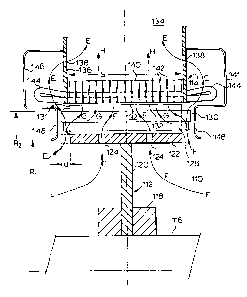Some of the information on this Web page has been provided by external sources. The Government of Canada is not responsible for the accuracy, reliability or currency of the information supplied by external sources. Users wishing to rely upon this information should consult directly with the source of the information. Content provided by external sources is not subject to official languages, privacy and accessibility requirements.
Any discrepancies in the text and image of the Claims and Abstract are due to differing posting times. Text of the Claims and Abstract are posted:
| (12) Patent: | (11) CA 2196363 |
|---|---|
| (54) English Title: | VENTILATION SYSTEM FOR AN AC MACHINE HAVING OVERHANGING SALIENT POLES WITH JUXTAPOSED SHROUDS |
| (54) French Title: | SYSTEME DE VENTILATION ET APPAREIL DE REFROIDISSEMENT D'AIR COMPRENANT DES POLES SAILLANTS EN SAILLIE AVEC BOUCLIERS JUXTAPOSES |
| Status: | Term Expired - Post Grant Beyond Limit |
| (51) International Patent Classification (IPC): |
|
|---|---|
| (72) Inventors : |
|
| (73) Owners : |
|
| (71) Applicants : |
|
| (74) Agent: | CRAIG WILSON AND COMPANY |
| (74) Associate agent: | |
| (45) Issued: | 2002-06-18 |
| (22) Filed Date: | 1997-01-30 |
| (41) Open to Public Inspection: | 1998-07-30 |
| Examination requested: | 1999-04-23 |
| Availability of licence: | N/A |
| Dedicated to the Public: | N/A |
| (25) Language of filing: | English |
| Patent Cooperation Treaty (PCT): | No |
|---|
| (30) Application Priority Data: | None |
|---|
A method of improving the airflow through a low to medium speed
salient pole dynamoelectric machine DEM is disclosed. The rotor rim on
which the salient poles are mounted is shortened in comparison to prior art
structures so that the ends of the salient poles (and the rotor windings)
protrude a substantial distance beyond the edge of the rim. A stationary or
rotating shield is placed in juxtaposed relationship with the rotating ends of
the salient poles to provide an enclosure so that the protruding ends of the
salient poles can function as a crude radial fan.
L'invention porte sur une méthode d'amélioration de l'écoulement d'air dans une machine dynamoélectrique à pôles saillants de faible à moyenne vitesse. La jante de rotor, sur laquelle les pôles saillants sont montés, est plus courte comparativement aux structures antérieures, de sorte que les extrémités des pôles saillants (et les enroulements du rotor) dépassent du bord de la jante de façon importante. Un bouclier fixe ou rotatif est juxtaposé aux extrémités rotatives des pôles saillants afin de créer une enceinte pour que les extrémités saillantes des pôles saillants puissent fonctionner comme un ventilateur rudimentaire à aubes radiales.
Note: Claims are shown in the official language in which they were submitted.
Note: Descriptions are shown in the official language in which they were submitted.

2024-08-01:As part of the Next Generation Patents (NGP) transition, the Canadian Patents Database (CPD) now contains a more detailed Event History, which replicates the Event Log of our new back-office solution.
Please note that "Inactive:" events refers to events no longer in use in our new back-office solution.
For a clearer understanding of the status of the application/patent presented on this page, the site Disclaimer , as well as the definitions for Patent , Event History , Maintenance Fee and Payment History should be consulted.
| Description | Date |
|---|---|
| Inactive: Expired (new Act pat) | 2017-01-30 |
| Letter Sent | 2007-11-06 |
| Letter Sent | 2007-10-25 |
| Inactive: IPC from MCD | 2006-03-12 |
| Inactive: IPC from MCD | 2006-03-12 |
| Grant by Issuance | 2002-06-18 |
| Inactive: Cover page published | 2002-06-17 |
| Pre-grant | 2002-03-21 |
| Inactive: Final fee received | 2002-03-21 |
| Notice of Allowance is Issued | 2001-10-12 |
| Letter Sent | 2001-10-12 |
| Notice of Allowance is Issued | 2001-10-12 |
| Inactive: Approved for allowance (AFA) | 2001-07-16 |
| Amendment Received - Voluntary Amendment | 2001-05-31 |
| Inactive: S.30(2) Rules - Examiner requisition | 2001-03-19 |
| Inactive: Office letter | 2000-09-28 |
| Inactive: Office letter | 2000-09-28 |
| Revocation of Agent Requirements Determined Compliant | 2000-09-28 |
| Appointment of Agent Requirements Determined Compliant | 2000-09-28 |
| Appointment of Agent Request | 2000-08-31 |
| Revocation of Agent Request | 2000-08-31 |
| Inactive: Status info is complete as of Log entry date | 1999-07-28 |
| Letter Sent | 1999-07-28 |
| Inactive: Application prosecuted on TS as of Log entry date | 1999-07-28 |
| All Requirements for Examination Determined Compliant | 1999-04-23 |
| Request for Examination Requirements Determined Compliant | 1999-04-23 |
| Inactive: Delete abandonment | 1999-03-23 |
| Deemed Abandoned - Failure to Respond to Maintenance Fee Notice | 1999-02-01 |
| Application Published (Open to Public Inspection) | 1998-07-30 |
| Abandonment Date | Reason | Reinstatement Date |
|---|---|---|
| 1999-02-01 |
The last payment was received on 2001-12-20
Note : If the full payment has not been received on or before the date indicated, a further fee may be required which may be one of the following
Please refer to the CIPO Patent Fees web page to see all current fee amounts.
Note: Records showing the ownership history in alphabetical order.
| Current Owners on Record |
|---|
| GENERAL ELECTRIC CANADA INC. |
| Past Owners on Record |
|---|
| MARTIN VANDUYN |